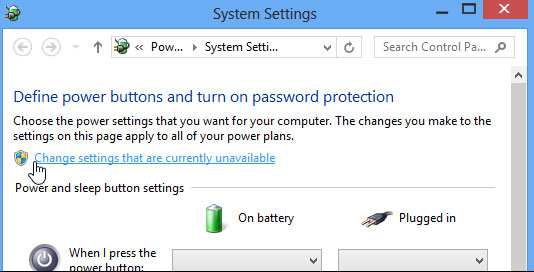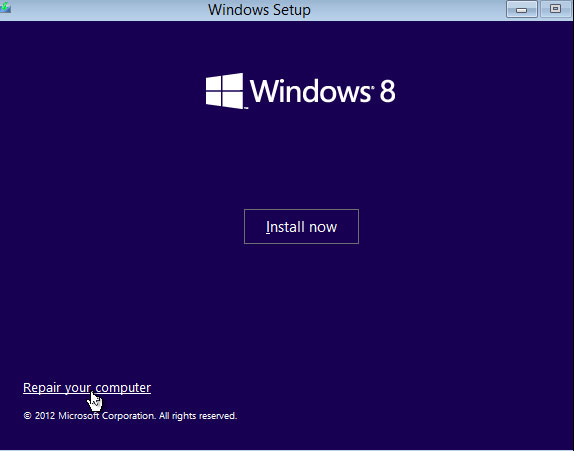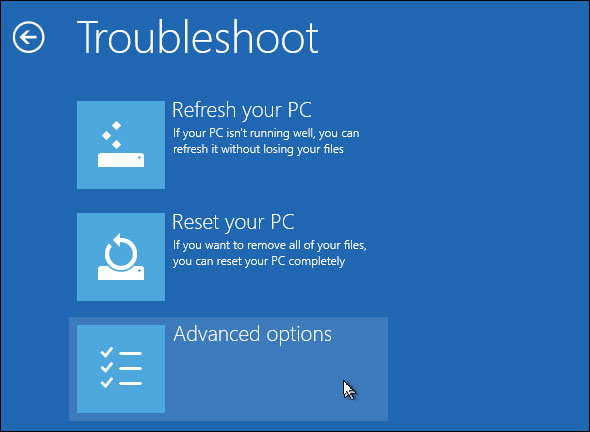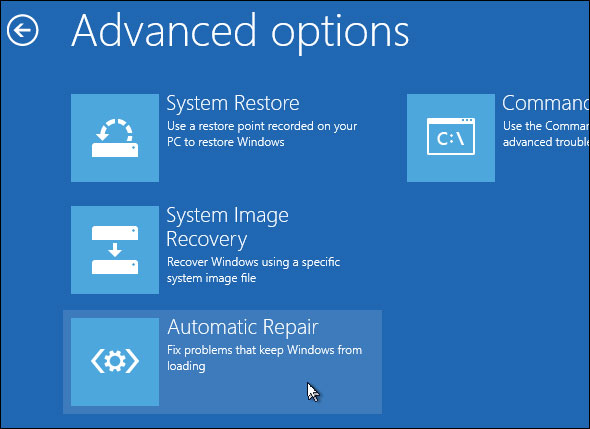How to fix boot errors on Windows 8
If you are using Windows 8, you will probably notice that this operating system gives an impressive boot time, much faster than previous Windows versions.That's because in Windows 8, Microsoft adopted a new boot feature called 'quick start', which is a combination of "cold" boot mode and hibernate boot mode.
With this feature, when you turn off the computer, in fact your system is not turned off completely as before (the data is deleted and then reloaded at the next boot), but the machine is still in a mode ' hibernate ' new. In this mode, drivers, services and other software will be pre-loaded in memory. When you boot up again, the system does not need to reload the entire hardware, as well as reload the drivers and services as before, making the boot process faster.
This way of booting is completely different from normal hibernation , because the previous hibernation feature means that the entire state of the system will be saved to memory, while 'quick start' does not save the chapters. the process you are running before shutting down.
However, this causes some problems. Some computer systems with older drivers do not seem to be compatible with this feature, causing the machine to not "hibernate" in the previous way. Therefore, the data used to boot the system fails may cause the machine to fail to boot, just like in the previous Windows versions .
Disable new features
If you're using Windows 8 and have trouble booting the system, you may want to disable the quick boot feature. However, it should be noted that this will cause the boot time of the machine to increase, but it is still more than letting the system fail.
You access the Charm bar of the operating system, select Settings then search for the keyword 'power settings', click on 'Change what the power buttons do'.

In the window that appears, click on the 'Change settings that are currently unavailable ' option near the top. In the next window, uncheck the 'Turn on fast startup (recommended)' field under the Shutdown settings section near the bottom of the window.

Click Next on the Save button and since then, Windows will boot in the old way in previous versions. As mentioned, the boot time will be longer but in return the machine no longer has a boot error. If after testing, the system still fails, you should re-enable this mode to improve the boot speed of the device.
Fix boot data error (Startup Data)
When booting from the hard drive, the machine will check the master boot record of the drive to load the boot loader and start the boot process. However, the master boot record itself (MBR) may be overwritten or the damaged boot data will cause the machine to fail to boot and report an error.
In this case, you can use the Windows boot installation disc or a bootable USB to perform the repair.
After inserting the disc into the optical drive or plugging in the USB and rebooting, you will see the Windows 8 installer appear. You select the language, keyboard type and then click inside until the window like the one below appears. Here you click on the option to 'Repair your computer' in the left corner of the window.

Click Troubleshoot, then Advanced Options.

The first thing you should try is to click on Automatic Repair to let Windows fix it automatically.

If this doesn't work, go to the Command Prompt window, enter the following commands and press Enter after each command:
bootrec / fixmbr
bootrec / fixboot
The first command will fix the master boot record for you, and the second command will help write a new boot sector for the hard drive.

In some cases, after these two commands, you may need to run the commands below:
bootrec / scanos
bootrec / rebuildbcd
The first command will scan the entire system for the operating system and include them in the boot configuration data to ensure that the boot loader knows where the Windows installation data is. The second command will also scan the system for the operating system but display a list and allow you to select the operating system you want to add.
Fix other errors

After the above two methods, if your Windows 8 computer still doesn't boot as usual, you may want to reset the machine to a stable state before. Notice that if the boot process fails, you will see the window below.
If not, you can boot the installation disc or USB device and access the Troubleshoot page . On the Troubleshoot screen, select Refresh your PC to reset the PC system files to the default state. Of course, you can also reinstall the operating system completely, but the Refresh feature of Windows 8 gives the same effect but the time is much faster.
You should read it
- How to fix Netflix errors that don't work on Windows 10
- How to fix Windows 8 error not connected to Windows Store
- How to fix a repeat boot error after updating Windows 10
- Fix Windows 10 error with just one click with FixWin
- Ways to fix computer laptop failures
- How to fix some errors on Windows 10 Creators
- Fix access errors for denied PST files after upgrading Windows 10
- Windows Repair supports fixing all errors on Windows
May be interested
- How to fix Windows 10 not booting error
 have you just upgraded or installed the windows 10 operating system and when you try to start your computer, you discover that windows 10 won't boot? if this is the situation you're facing, try the solutions below to see if they resolve windows 10 startup problems.
have you just upgraded or installed the windows 10 operating system and when you try to start your computer, you discover that windows 10 won't boot? if this is the situation you're facing, try the solutions below to see if they resolve windows 10 startup problems. - Instructions to edit or replace Boot.ini file on Windows XP
 boot.ini is a hidden file used to identify folders on the partition, and the directory location located on the windows xp hard drive. however, sometimes for some reason the boot.ini file may be damaged, corrupted, or deleted.
boot.ini is a hidden file used to identify folders on the partition, and the directory location located on the windows xp hard drive. however, sometimes for some reason the boot.ini file may be damaged, corrupted, or deleted. - Steps to fix dual boot option not showing in Windows 10
 if your dual-boot system doesn't show the operating system selection menu or windows boot manager during boot, you're not alone. the lack of a dual boot option is common on newly created dual boot systems, mainly caused by an incorrectly configured boot manager.
if your dual-boot system doesn't show the operating system selection menu or windows boot manager during boot, you're not alone. the lack of a dual boot option is common on newly created dual boot systems, mainly caused by an incorrectly configured boot manager. - How to speed up Windows 10 startup
 windows 10 boots slowly like a crawl, is there any way to speed up windows 10 when booting? yes, here are ways to speed up windows 10 boot for you, very simple and easy to do.
windows 10 boots slowly like a crawl, is there any way to speed up windows 10 when booting? yes, here are ways to speed up windows 10 boot for you, very simple and easy to do. - 20 best USB boot software
 20 this usb boot software will help you create usb boot, usb install win quickly, easily, even can create usb boot containing many operating systems.
20 this usb boot software will help you create usb boot, usb install win quickly, easily, even can create usb boot containing many operating systems. - How to create USB Boot, USB install Windows by Rufus
 how to create usb boot installed win is pretty much, you can create usb boot with hiren's boot cd, universal usb installer, ... but the quick, easiest way is to create a boot usb with rufus. the following is a guide to creating a usb boot using rufus for your reference.
how to create usb boot installed win is pretty much, you can create usb boot with hiren's boot cd, universal usb installer, ... but the quick, easiest way is to create a boot usb with rufus. the following is a guide to creating a usb boot using rufus for your reference. - How to run Windows programs on Mac
 virtual widows allows you to run many windows applications and software. however, if the application you want to run a full horsepower request for mac, then all the resources on the virtual machine are not enough will cause some serious errors. in this case you can use boot camp assistant. boot camp assistant is an integrated apple utility on mac, allowing users to dual-boot mac with windows.
virtual widows allows you to run many windows applications and software. however, if the application you want to run a full horsepower request for mac, then all the resources on the virtual machine are not enough will cause some serious errors. in this case you can use boot camp assistant. boot camp assistant is an integrated apple utility on mac, allowing users to dual-boot mac with windows. - How is Windows Safe Mode and Clean Boot different?
 basically, clean boot and safe mode are quite similar, even performing the same function. one provides users with a clean environment to start windows and one provides a safe mode for users to access and fix errors.
basically, clean boot and safe mode are quite similar, even performing the same function. one provides users with a clean environment to start windows and one provides a safe mode for users to access and fix errors. - How to create Windows 10 installation USB using Rufus, Boot UEFI and LEGACY
 creating a windows 10 installation usb with rufus, boot uefi and legacy is an important step to upgrade or reinstall the windows operating system. to do this, you need a blank usb and a standard windows 10 installer. proceed to create a bootable usb to install windows 10 using rufus according to the instructions below. this is an easy way to get an important tool to fix errors or speed up your computer.
creating a windows 10 installation usb with rufus, boot uefi and legacy is an important step to upgrade or reinstall the windows operating system. to do this, you need a blank usb and a standard windows 10 installer. proceed to create a bootable usb to install windows 10 using rufus according to the instructions below. this is an easy way to get an important tool to fix errors or speed up your computer. - How to restore Master Boot Record in Windows 10
 master boot record (mbr) is a special type of boot sector found when starting the system partition. mbr informs about the upcoming boot process such as partition distribution, size, file system, etc. a mbr traditionally contains a small part of executable code, turning the boot process into the appropriate operating system. .
master boot record (mbr) is a special type of boot sector found when starting the system partition. mbr informs about the upcoming boot process such as partition distribution, size, file system, etc. a mbr traditionally contains a small part of executable code, turning the boot process into the appropriate operating system. .










 How to customize the Windows 8.1 interface
How to customize the Windows 8.1 interface 9 Windows 8.1 errors have not been resolved
9 Windows 8.1 errors have not been resolved Use Windows XP Mode on Windows 8
Use Windows XP Mode on Windows 8 How to optimize Windows 8.1 for traditional computers
How to optimize Windows 8.1 for traditional computers Prevent 'blue screen errors' on Windows 8
Prevent 'blue screen errors' on Windows 8 Instructions for installing Windows 8.1 on Mac
Instructions for installing Windows 8.1 on Mac